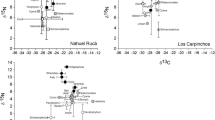Abstract
Examination of the gut contents of mud-dwelling animals in three newly flooded lakes shows terrestrial organic matter to be a major component, particularly during filling of the lake basin. After filling is complete, a fall-off in total biomass of fauna is usually accompanied by significant reduction in the proportion of terrestrial detritus in favour of algal food. It is concluded that newly formed lakes pass through two phases. During flooding they are dependent on the terrestrial ecosystem. This is followed by a switch, immediately after filling, to more self-sustained autochthonous-based food chains.
Similar content being viewed by others
References
Andronikova, I. M., Drabcova, W. G., Kuzemenko, K. M., Michalova, N. F. & Stravinskaja, E. A. 1970. Biological productivity of the main communities of the red lake. p. 1–12. In: Productivity Problems of Freshwaters. Preliminary papers. IBP-UNESCO Symposium Kazimierz May 1970. 1
Boyd, C. M. 1976. Selection of particle sizes by filter-feeding copepods. A plea for reason. Limnol. Oceanogr. 21: 175–180.
Coffman, W. P., Cummins, K. W. & Wuycheck, J. C. 1971. Energy flow in a woodland ecosystem: 1. Tissue support trophic structure of the autumnal community. Arch. Hydrobiol. 68: 232–276.
Cummins, K. W., Miller, L. D., Smith, N. A. & Fox, R. M. 1965. Experimental Entomology. Rhineland, London.
Egglishaw, H. J. 1964. The distributional relationship between bottom fauna and plant detritus in streams. J. Anim. Ecol. 33: 463–476.
Fittkau, E. J. & Klinge, H. 1973. On biomass and trophic structure of the central Amazonian rain forest ecosystem. Biotropica 5: 2–14.
Gak, G. Z., Gurivch, V. V., Koreljakova, I. L., Kostikova, L. E., Konstantinova, N. A., Olivary, G. A., Prijmachenko, A. D., Tseeb, Y. Y., Vtadirirova, K. S. & Zimbalevskaya, J. M. 1970. Productivity of Aquatic Organisms. Communications of different trophic levels in Kiev Reservoir. p. 83–94. In: Productivity Problems of Freshwaters. Preliminary Papers. IBP-UNESCO symposium Kazimierz May 1970. 1.
Hynes, H. B. N. & Kaushik, N. K. 1969. The relationship between dissolved nutrient salts and protein production in submerged autumnal leaves. Verh. Internat. Verein. Limnol. 17: 95–103.
Jonasson, P. M. & Kristinsen, J. 1967. Primary and Secondary production in Lake Esrom. Growth of Chironomus anthracinus in relation to seasonal cycles of phytoplankton and dissolved oxygen. Int. Rev. ges Hydrobiol. 52: 163–217.
Mann, K. H. 1969. The dynamics of aquatic ecosystems. In: Advances in Ecology Research 6. (Ed. J. B. Cragg). pp. 1–81. Academic Press. New York.
McLachlan, A. J. 1969. The effect of aquatic macrophytes on the variety and abundance of benthic fauna in a newly created lake in the tropics (Lake Kariba). Arch. Hydrobiol. 66: 212–231.
McLachlan, A. J. 1970. Some effects of annual fluctuations in water level on the larval chironomid communities of Lake Kariba. J. Anim. Ecol. 39: 79–90.
McLachlan, A. J. 1974a. Development of some lake ecosystems in tropical Africa, with special reference to the invertebrates. Biol. Rev. 49: 365–397.
McLachlan, A. J. 1974b. The development of chironomid communities in a new temperate impoundment. Ent. Tidskr. 95 (Suppl.): 162–171.
McLachlan, A. J. 1974c. Recovery of the mud substrate and its associated fauna following a dry phase in a tropical lake. Limnol. Oceanogr. 19: 74–83.
McLachlan, A. J. 1975. The role of aquatic macrophytes in the recovery of the benthic fauna of a tropical lake after a dry phase. Limnol. Oceanogr. 20: 54–63.
McLachlan, A. J. 1977. Some effects of tube shape on the feeding of Chironomus plumosus L. (Diptera: Chironomidae). J. Anim. Ecol. 46: 139–146.
Morduchai-Boltovskoi, F. B. 1961. Die Entwicklung der Bodenfauna in den Stauseen der Wolga. Verh. Internat. Verein. Limnol. 14: 647–651.
Moss, B. 1968. Studies on the degradation of chlorophyll ‘a’ and carotenoids in fresh waters. New Phytol. 67: 49–59.
Pechlaner, R., Bretschko, G., Gollman, H., Tilzer, M. & Weissenbach, H. P. 1972. Ein Hochgebirgssee (Vorderer Finstertaler See, Kuhtai, Tirol) als Modell des Energientransportes durch ein Limnisches Ökosystem. Verh. d. Dtsch. Zool. Ges. 4: 47–56.
Vallentyne, J. R. 1960. Fossil pigments. In: Comparative Biochemistry of Photoreactive Systems (Ed. by Allen, M. B.) pp. 83–105. Academic press. New York.
Author information
Authors and Affiliations
Rights and permissions
About this article
Cite this article
McLachlan, A.J. The changing role of terrestrial and autochthonous organic matter in newly flooded lakes. Hydrobiologia 54, 215–217 (1977). https://doi.org/10.1007/BF00014287
Received:
Published:
Issue Date:
DOI: https://doi.org/10.1007/BF00014287




